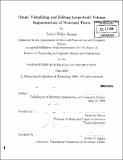Omni : visualizing and editing large-scale volume segmentations of neuronal tissue
Author(s)
Shearer, Rachel Welles
DownloadFull printable version (22.71Mb)
Alternative title
Visualizing and editing large-scale volume segmentations of neuronal tissue
Other Contributors
Massachusetts Institute of Technology. Dept. of Electrical Engineering and Computer Science.
Advisor
Sebastian Seung.
Terms of use
Metadata
Show full item recordAbstract
Connectomics researchers examine images of the brain in order to determine the structure of neuronal networks. As imaging techniques improve, images are growing in size and resolution - but they are also outgrowing the capacity of existing software to view these images. In response to this problem, this thesis presents OMNI: an application for viewing and editing large connectomic image volumes. OMNI employs pre-processing and caching techniques to allow researchers to examine large image volumes at multiple viewpoints and resolutions. But OMNI is also a full-fledged navigation and editing environment, incorporating the suggestions of connectomics researchers into a simple and flexible user interface design. The OMNI user interface features multiple synchronized display windows and a novel project inspector widget that facilitates project interaction. The 2D navigation and editing modules use OpenGL textures to display image slices from large image volumes and feature a texture management system that includes a threaded texture cache. Editing is performed by painting voxels in a viewing window and allows the user to edit existing neuron tracings or create new ones. The development of OMNI gives connectomics researchers a way to view detailed images of the nervous system and enables them to trace neural pathways through these large images. By studying the structure of individual neurons and groups of neurons, researchers can approach a better understanding of neuron function and the development of the brain.
Description
Thesis (M. Eng.)--Massachusetts Institute of Technology, Dept. of Electrical Engineering and Computer Science, 2009. Includes bibliographical references (leaf 69).
Date issued
2009Department
Massachusetts Institute of Technology. Department of Electrical Engineering and Computer SciencePublisher
Massachusetts Institute of Technology
Keywords
Electrical Engineering and Computer Science.